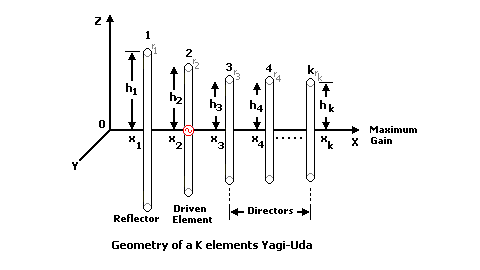
Yagi-Uda basics
Part 2; Geometry of the Yagi-Uda

Each element is made by wire; rod or conductor tube with is own particular characteristic, very often aluminum.
h1, h2, h3 ... hk in the above graph, is the eighth of half element put symmetric to the X-axis which is called antenna boom. Then the physical length of each element k is 2hk. Every element have is own radius rk, generally of the same diameter 2rk by the manufacturers, but should be different. The xi-x1 values give the relative position of each element to the reflector element, xk-x1 is always the boom length of the antenna; generally x1 is put to zero in some design description. In some design method a spacing elements Xi- Xi-1 is given instead the relative position. Element 1 is always the reflector element, the 2 is the driven element, and 3 is the first director. More than one director should be use, an antenna with ten directors is a twelve elements Yagi-Uda.
Gain relationship with impedance and F/B ratio
The Gain alone should not be the primary choice in Yagi-Uda array design, since F/B ratio and impedance bandwidth value are highly influenced. Yagi-Uda design needs compromises in Gain, Front/Side-lobes ratio for both E and H plane and the Impedance bandwidth to avoid impractical or unusable antenna to meet your own requirements. Generally, a loss gain has required to getting better overall and stable antenna performance, the dream antenna not exist in the physical world.
It is very hard to get high F/B ratio, i.e. a low noise antenna, when antenna project require maximal gain. Lowering the radiator impedance seems to help to get better F/B ratio but minor side lobes should be take in consideration.
The skin loss and the Joule effect in the elements can dissipate a lot of energy at lower impedance values, resulting in an effective lowers gain than what would expected by the theoretical calculus. If the space lengths between elements have too closed, a severe instability could result such as both elements length and position tolerance as a small fraction of inch; very high susceptibility to environment condition could result also.
About the feeder, an open dipole radiator is easier to match as driven element much better than a folded dipole in home brew design. To perfect match avoid to move the first radiator, instead but move slightly the radiator element backward to reflector or forward to the director.
Then a nice and stable antenna could show a lower Gain than an extreme gain antenna design. Better performance could result but intrinsic impedance and bandwidth drop down when both low noise antenna and higher gain is required.
[ Yagi-Uda basics; Part 1, general ]
[ index page ] [ basics 1 ] [ basics 2 ] [ measure ] [ acronym and definitions ] [ sample/repository: ] [ 3 elements Yagi-Uda ] [ 4 elements Yagi-Uda ] [ 5 elements Yagi-Uda ] [ 6 elements Yagi-Uda ] [ 7 elements Yagi-Uda ] [ 8 elements Yagi-Uda ] [ 9 elements Yagi-Uda ] [ 10 elements Yagi-Uda ] [ 11 elements Yagi-Uda ] [ Coaxial Balun ] [ Link to us; Free code ] [ Terms of use; Disclaimer; Privacy policy ] [ site map; contents ]
Copyright © 2008 Yagi-Uda.com, All Rights Reserved.
Created Date: Sat, 12 Apr 2008 10:10:01 z by Yagi-Uda.com
Last modified Date: February 02, 2012 13:42:15 z by Yagi-Uda.com